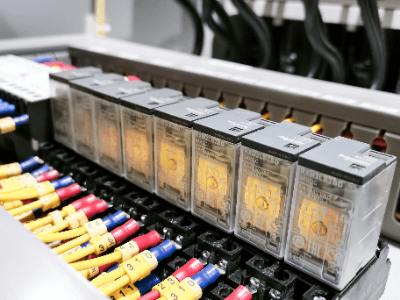What Is a Control Relay?
 A control relay is a component that receives an electrical signal and outputs a digital signal to control a machine.
A control relay is a component that receives an electrical signal and outputs a digital signal to control a machine.
The name “control relay” is derived from the image of a baton relay, in which one input originates and affects another output.
Uses of Control Relays
Control relays are one of the most widely used components in industry and everyday life. The following are examples of control relay applications:
- Control of automatic conveying equipment
- Inside PLCs (Programmable Logic Controllers)
- Inside personal computers
- Inside home appliances such as air conditioners and automatic vacuum cleaners
- Inside transport vehicles such as automobiles and motorcycles
Mainly used to pass input signals from sensors or push buttons to another device. Because they are used in places where control is being performed, they are used not only in industrial equipment but also in electrical appliances.
If the control system is complex, reproducing it with control relays requires several hundred points and is complicated, so PLCs and PCs are used to output calculations. However, if only a few relays are used, it is cheaper and easier to use electromagnetic relays for control.
Principle of Control Relay
There are two types of control relay, one with a contact point and the other without a contact point.
1. With-Contact Relays
Contact relays are relays that mechanically operate their contacts to output a contact signal. They are also called mechanical relays because of their operating principle. It consists of electromagnetic coils and contacts.
When the relay receives an input voltage signal, the internal electromagnetic coil is excited. The excited electromagnetic coil acts as an electromagnet and operates the movable contact, which moves together with the movable iron strip. The movable contact makes contact or pulls away from the fixed contact and outputs an electrical contact signal.
When the input voltage is removed, the contacts return to their positions by being pushed back by an internal return spring. The electromagnetic coil consists of copper wire wound around an iron core and coated with varnish for insulation.
In addition, silver alloys or gold are used on the contacts to reduce electrical resistance. They are generally protected by a casing to prevent easy human contact.
2. Contactless Relay
A contactless relay is a component that uses a semiconductor to output a contact signal without physically operating the contact. Because of their operating principle, they are also called solid-state relays. The main component of a solid-state relay is a photocoupler.
First, when a voltage is applied to the input terminal, the LED inside the photocoupler is excited, and the LED generates light that is directed to an internal light-receiving element. The light-receiving element uses a phototransistor that conducts by light and thus outputs a contact signal by the light from the LED.
The characteristic of a contactless relay is that there is no mechanical contact, as in the case of a relay with a contact point, so there is no metal wear due to opening and closing operations. The transmission speed is also high, making it suitable for high-speed and high-frequency opening and closing. Other features include good insulation, no need for noise suppression, easy miniaturization, and no operating noise.
However, a drawback is that semiconductor elements are quickly damaged when voltages and currents exceeding their ratings are applied. They are vulnerable to heat and require adequate heat dissipation measures. They are also more expensive than contact relays.
Types of Control Relays
Control relays have the following three types of contacts:
1. A-Contact
The A-contact is a contact that is open when no signal is input to the input terminal and conducts when a signal is input. It is also called a normally open contact or a make contact. It is the most common type of contact that provides signal isolation only.
2. B-Contact
The B-contact is a contact that conducts when no signal is input to the input terminal and opens when a signal is input. It is also called a normally closed contact or a break contact.
It is characterized by the opposite action of the A-contact and can invert and output the input signal. It is often used in interlock circuits and fault interrupting circuits.
3. C-Contact (Transfer Contact)
The C-contact is a three-terminal contact that combines an A-contact and a B-contact. It has three terminals: a common terminal, an A-contact terminal, and a B-contact terminal. When no signal is input to the input terminal, the common-b contact terminal is conducting and the common-a contact terminal is open.
When a signal is input to the input terminal, the common terminal-b contact terminal is open and the common A-contact terminal is conducting. It is used for circuits that switch between forward and reverse rotation. Another feature of the C-contact is that it is applicable only to contact relays.